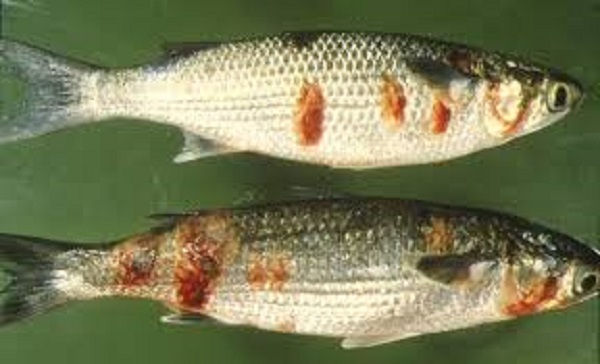 • Tail and fin rot: The symptoms are rotting of tail and fin, light white color is seen at the corner of the fin, and then spread all around the fin and then finally fall.
• Tail and fin rot: The symptoms are rotting of tail and fin, light white color is seen at the corner of the fin, and then spread all around the fin and then finally fall.
Treatment: Treatment with copper sulphate @0.5% is done. The fish is drowned in treated water for 2-3 mins.
 • Gill rot: The symptoms are gray color gills and then they finally fall. The breath of fish will squeeze and they come at the upper layer of water to take the breath and at the end they will die due to breath squeezing.
• Gill rot: The symptoms are gray color gills and then they finally fall. The breath of fish will squeeze and they come at the upper layer of water to take the breath and at the end they will die due to breath squeezing.
Treatment: Fishes are drowned in 3-5% salt water for 5-10 min to treat from disease.
 • Epizootic Ulcerative Syndrome: The symptoms are ulcers on body, fall of skin and fin and then ultimately death of the fish.
• Epizootic Ulcerative Syndrome: The symptoms are ulcers on body, fall of skin and fin and then ultimately death of the fish.
Treatment: Put 200 kg/acre of lime in water and don’t put fertilizers in the water.
 • White spot disease: White patches are seen on skin, gills and fins of the fish.
• White spot disease: White patches are seen on skin, gills and fins of the fish.
Treatment: Drown the fish into formalin solution@0.02% for 7-10 days for 1 hour.
 • Black spot disease: Small spots of black color are seen on the body.
• Black spot disease: Small spots of black color are seen on the body.
Treatment: Drown the fish into picric acid solution@0.003% for 1 hour.
 • Argulosis: The symptoms are slow growth, loose fin and blood spots on skin.
• Argulosis: The symptoms are slow growth, loose fin and blood spots on skin.
Treatment: Add Malathion (50 EC) @1l/acre at the interval of 15 days for 3 times.
 • Leech: The symptoms are wounded skin and gills.
• Leech: The symptoms are wounded skin and gills.
Treatment: put 1l/acre of Malathion to treat the disease.
 • Vibriosis: The symptoms are white or grey color lesions are found on the spleen and intestines.
• Vibriosis: The symptoms are white or grey color lesions are found on the spleen and intestines.
Treatment: Dose of oxytetracycline @3-5gm/100lb of fish/day is given for 10 days or dose of Furazolidone is given in feed @100mg/kg/fish for 6 days.
 • Furunculosis: The symptoms are darkening of skin, enlarged spleen, rapid breathing and bloody mucous. This disease will increase the mortality among fishes.
• Furunculosis: The symptoms are darkening of skin, enlarged spleen, rapid breathing and bloody mucous. This disease will increase the mortality among fishes.
Treatment: Dose of Sulfamerazine @150-220mg/kg fish weight/day is given for 10-14 days or dose of Furazolidone is given in feed @25-100mg/kg fish weight/day for 10 daysor dose of oxytetracycline @50-70mg/kg fish weight/day is given for 10 days or dose of Oxolinic acid is given in feed @25-100mg/kg fish weight/day for 10 days.
 • Red mouth disease: The symptoms are reddening of fins, mouth, throat and gill tips.
• Red mouth disease: The symptoms are reddening of fins, mouth, throat and gill tips.
Treatment: Several antibiotics and vaccinations are available which are used to cure red mouth disease.






















